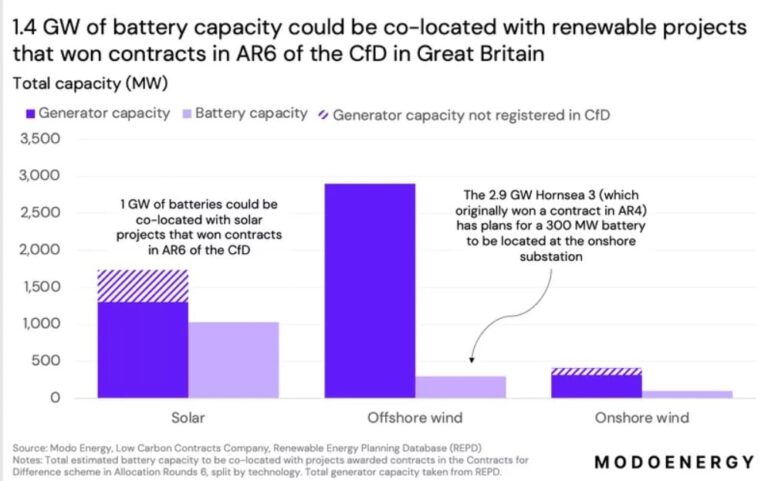Modo Energy analysis has found that renewable energy projects awarded contracts under the Contracts for Difference (CfD) Allocation Round 6 (AR6) will include 1.4 GW of co-located battery energy storage systems (BESS). could facilitate.
Although BESS projects themselves cannot participate directly in the CfD auction, projects that have been awarded contracts can be placed together with a battery. Following changes to the rules after Allocation Round 4, BESS co-location is now a much easier prospect for generators, and AR6 saw a record number of awards for solar projects.
Modo Energy’s analysis shows that 5 GW of the 9.6 GW of renewable energy capacity allocated in AR6 could be suitable for, or has already unveiled plans for, co-located battery storage. As a result, as much as 1.4 GW of BESS capacity could be created as part of new renewable projects arising from the AR6.
Using an average ratio of 60 MW of BESS capacity for every 100 MW of solar generation capacity, Modo Energy has calculated that 1 GW of this potential BESS capacity could come from solar projects alone.
Of these, Modo Energy suspects that EDF Renewables’ 500MW Longfield Solar Energy Farm could bring together the largest battery in this allocation round with renewable energy sources. Although the location has a building permit for BESS co-location, it has no stated capacity; Based on the average ratios for known co-located BESS capacities from AR6, Modo Energy predicts that a BESS at Longfield would have a capacity of 300 MW, but if EDF Renewables chooses to deploy its solar generation and storage capabilities for this project match, a Longfield BESS could be as large as 500 MW.
The potential for co-located BESS of AR6 significantly exceeds that of AR5, an allocation round in which significantly less renewable capacity was awarded in total. Modo Energy estimates that 1.1 GW of the 3.6 GW of projects winning contracts in AR5 could see co-located BESS, which is expected to deliver a total of 750 MW of storage capacity.

The total battery capacity expected to be co-located with CfD-supported projects from AR4 to AR6 could be as high as 3.1 GW. Although none of the batteries planned for co-location with renewables from AR4 have commenced commercial operations, co-located batteries are not part of the CfD agreement and therefore do not have to come online on the agreed generator commissioning date.
According to Modo Energy, the number of co-located BESS projects as CfD renewable energy projects could be as much as eleven times the number of currently existing co-located BESS projects. There are currently eight co-located battery sites above 7MW commercially operational in the UK, and 77 sites from the AR4 – AR6 allocation rounds could be co-located with energy storage. If these 77 locations power their BESS next to the target commissioning date, these batteries could all be online by 2028.


